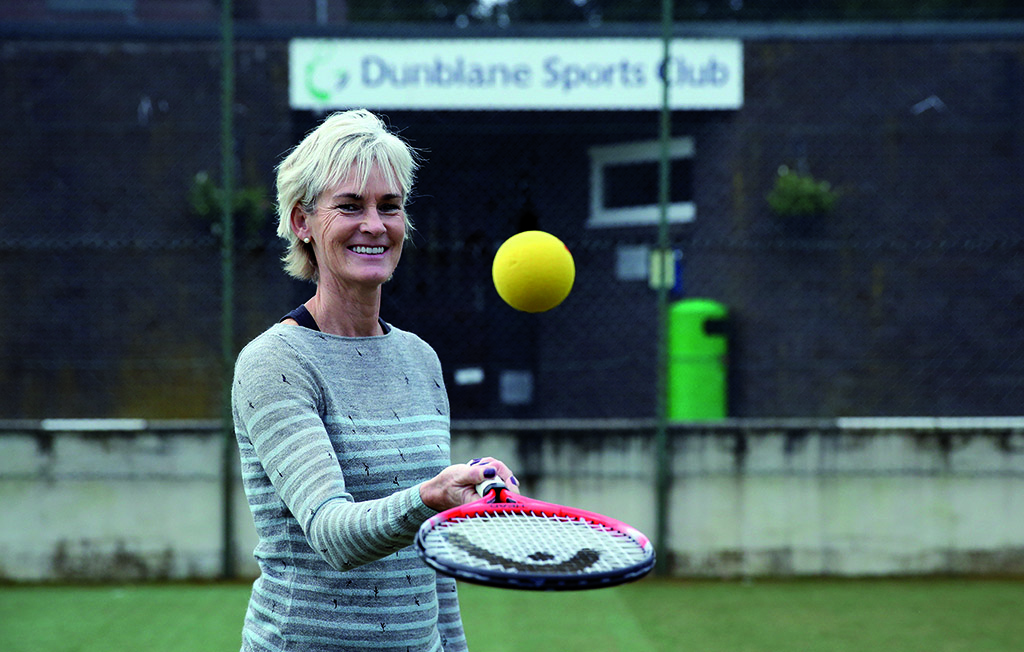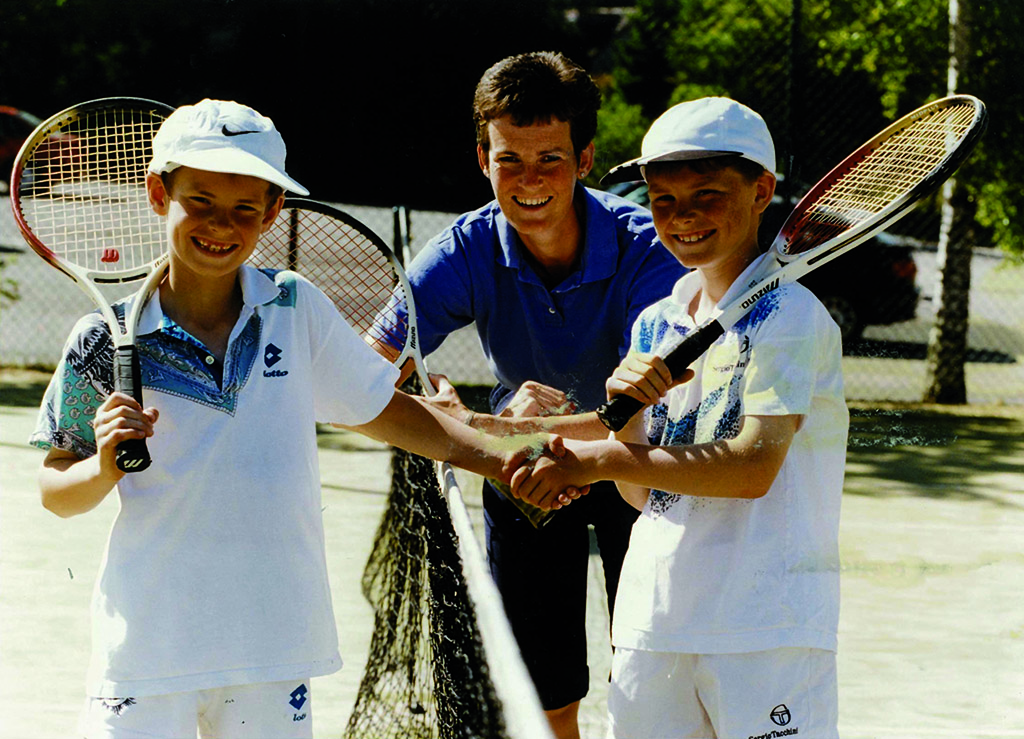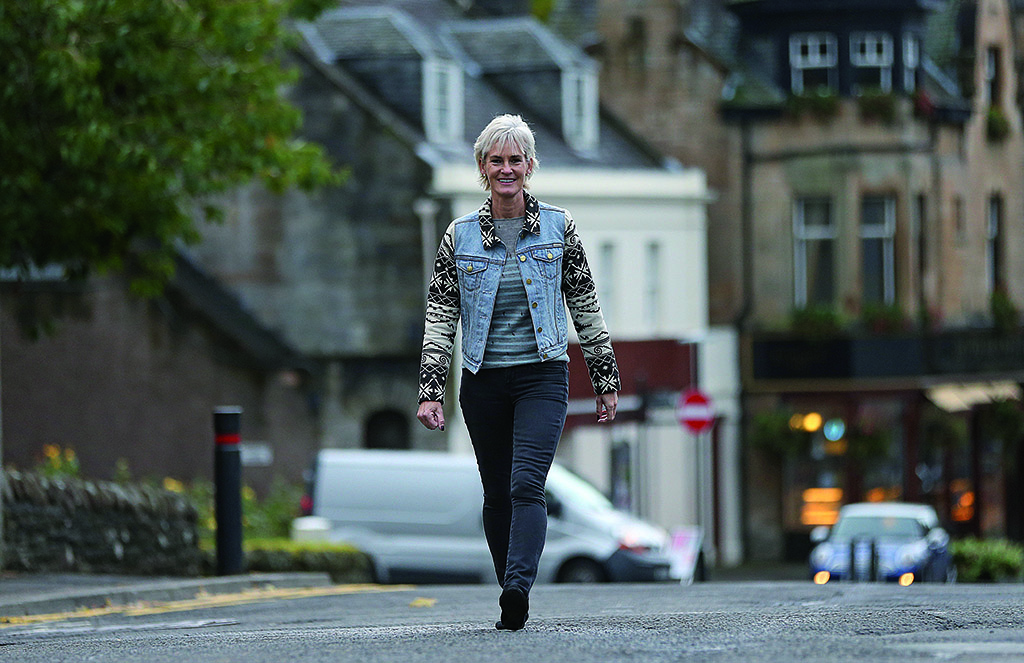
Dunblane is the perfect match for Judy Murray
Judy Murray grew up and raised her tennis prodigy sons Andy and Jamie in the historic Stirlingshire town of Dunblane.
Andy, who won 45 career titles in his career – a double Wimbledon champion, double Olympic gold medal winner, and US Open winner – and doubles ace Jamie, who has won six Grand Slam titles in both men’s and mixed, always pay tribute to their mum’s influence on their game.
In this feature, originally published in Scottish Field in 2013, she discusses how Dunblane has shaped the life of herself and her family.
We moved to Dunblane from Stirling when I was five and my dad opened his own practice, RS Erskine Opticians, in the high street. There are four practices now, but Dunblane was his first. Last month it celebrated 50 years of trading. My brother and his wife run it now, so it’s a real family affair.
Back then Dunblane had a population of three thousand and was very much a village.
I went to Dunblane primary school until the end of primary four when my parents moved me to Morrison’s Academy in Crieff because there was no high school in Dunblane. I’ll be forever grateful because it gave me so many great opportunities, especially in sport which was and is important to me. I did everything from netball, hockey, swimming and diving to tennis and badminton.
The thing I loved about school sport was being part of a team: I still love the idea of team spirit, the motivation and sense of belonging you get from playing in a team, and the friends you make.
I was a real tomboy and very sporty. My two brothers were six and three years younger than me, my dad had played for Hibs and both my parents were county tennis and badminton players.
I grew up loving sport, as did my brothers: Keith is a golf pro (I’m the only one of the family that doesn’t play – it’s too slow for me) and younger brother Niall does a bit of everything. The age gap between me and them was too big for us to develop the kind of sibling rivalry that Jamie and Andy enjoyed, but we all learned how to compete at school and at various community sports clubs.

Judy Murray enjoyed both tennis and badminton in her youth (Photo: Ian MacNicol)
Growing up in Dunblane, my life was dominated by the tennis club and the badminton club, which was one court in the hall at the back of St Mary’s Church, on the roundabout. It was run by a parent of a boy that played there and was a real community club run by volunteers.
My parents were community-minded people. Dad was a big fundraiser for many local causes, and raised a lot of the money that built the Scout hut. They were big into things like the Ladies Circle and Round Table, and for years he ran a golf day at Dunblane golf club called the AmAm that raised hundreds of thousands of pounds for Strathcarron Hospice. He is a great organiser and my younger brother and I have that same sense of wanting to do things in the community.
A strong childhood memory was walking down to the high street each Saturday with my mum’s message basket and getting everything on her shopping list. After that I’d ride my bike down to the tennis club and camp out there all afternoon, playing whoever was there. As there were no indoor tennis courts we played badminton in the winter, which I loved.
I started by playing at the church, then graduated to the club at the Victoria Hall beside the station where my mum and dad played. Then, as I improved I played at the drill hall in Stirling with a regional squad. As a youngster, understanding the importance of sport in the community all came from the badminton and tennis clubs.
I left for Edinburgh University aged 17, then worked in Glasgow and Peterborough and didn’t come back until literally two weeks before Andy was born. I returned to Dunblane because I’d had such a nice, normal childhood and wanted that for my children. It’s such a great place for families: the schools are good and there’s a community feel about the town. Niall and his wife also came back to Dunblane around the same time.

Judy Murray with young Andy and Jamie (Photo courtesy of Judy Murray)
Dunblane had a new feel by then because it had got a little bit bigger and the high street wasn’t as dynamic as it once was. I didn’t know many people my age because many of my school pals had moved away, but there were still lots of people I knew at the tennis club, even if the old blaize courts had gone and there was a new clubhouse with squash courts. It was very different from the wooden pavilion, which I loved because it was so basic.
When I came back, I volunteered at the tennis club because that was a natural thing to do and I wanted to keep active. It was still a community club and I’m just a big believer in sport bringing communities together. That said, society has changed from when I was young – kids don’t bike down the tennis courts to hang out any more because they need a key to open the tennis club, whereas you could always go to the loo in our old pavilion or get a drink there.
Dunblane’s population is now about 10,000 and it has outgrown its infrastructure. It’s an historic town in which the high street has a narrow one-way street, and there’s not much room for parking. When a big supermarket opened by the railway line twenty years ago it took a lot of people away from the high street and affected many local businesses, which we felt a lot because our family shop is there.
Yet there is still so much that’s good about Dunblane. We have lots of facilities in the schools and community centre, and are near to Stirling where you can try almost every sport, and there’s an ice rink, cinema and swimming pool.
When Jamie and Andy wanted to learn rugby we went to Stirling County; they got football at school and then at a wee club in Auchterarder or at Gairdoch in Falkirk as they got older. Both boys went to cubs, and I taught them how to swim at the Rainbow Slides but that was a pretty basic pool so we’d go to Perth or Coatbridge for more adventurous swimming.

Judy Murray in her beloved Dunblane (Photo: Ian MacNicol)
We were members of the country club at Gleneagles, which had a par-three golf course, swimming pool, pitch ‘n putt, maze, a great cycle path and outdoor tennis courts, so that was perfect – we spent a lot of time up there.
I grew up playing in a really super park in the Laighills behind the Cathedral, and so did Andy and Jamie. They’ve added a skate park in there and there are walks along the side of the River Allan, plus a football pitch and streams where you can skim stones and paddle.
There’s also a duck pond right beside the tennis club and when I coached kids, because I couldn’t afford childcare the payback was that their parents would look after Jamie and Andy in the clubhouse or take them across the park to feed the ducks for the hour I was working with their kids.
The duck pond was a big thing when I was growing up and also when the boys were toddlers. They loved feeding the ducks and watching the ducklings, frogs and tadpoles. There’s lots of great walks but we especially loved the Darn Walk from Dunblane to Bridge of Allan along the side of the golf course. We would walk with my mum and dad’s golden retriever Abby when Jamie and Andy were small.
My dad is a great walker so when I was young every Sunday we went on a family walk. He grew up in Bridge of Allan, where I now live, so we would go up to the woods there, up Pendreich Road and down Cockburn Brae, that whole walk that joins Bridge of Allan to Dunblane. My dad knows all the walks so when the boys were small he used to take them and the dog out walking to the Old Orchard and Doune Ponds, where he’d teach them to skim stones.
When they weren’t outside with me or their dad, they grew up walking and playing outside with their granny and grandpa. It was all pretty basic but it’s the stuff that a good childhood is made of.
There was, of course, one point at which the boys’ childhood wasn’t as normal or as happy as mine. I can only speak on how I see the Dunblane tragedy, I’m not a spokesman for the town, but I think it definitely brought the town closer together in the immediate few years after the tragedy.
The town has recovered really well, but in the last five or six years it has grown so much – there’s now a primary school on either side of town – that it has almost outgrown its past. The community centre, built with the money that came into the town after the tragedy, is a constant reminder, but unlike when I was a girl and everybody knew everybody, the many new people in the town weren’t part of the community in those dark days and are thankfully not scarred by it.
- This feature was originally published in December 2013.
TAGS

